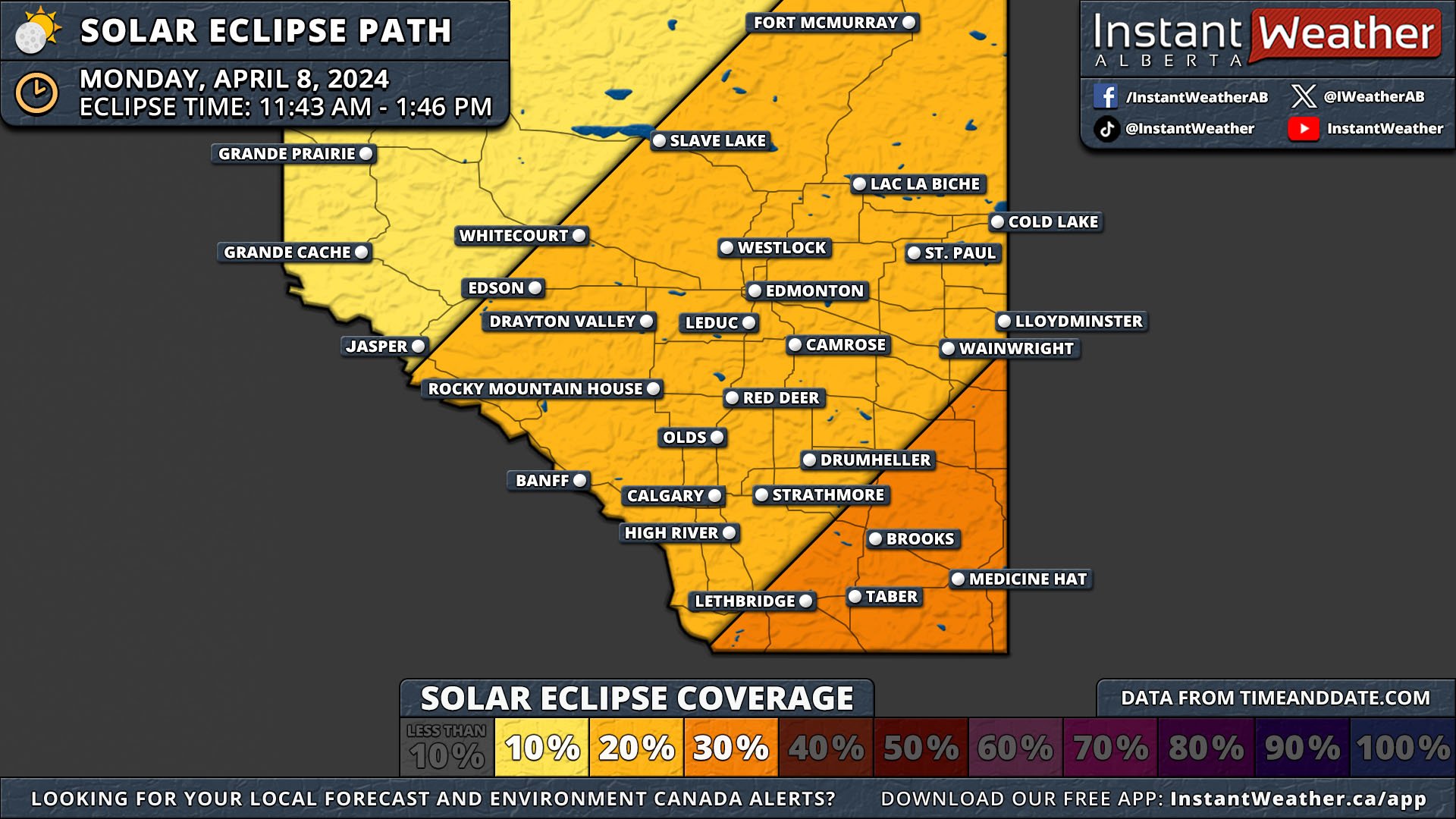Partial Solar Eclipse Will Be Visible Across Alberta on April 8th
/NOTE: YOU CAN CLICK ON THE MAP TO OPEN A ZOOMABLE IMAGE
Alberta is in for a rare celestial display of a solar eclipse on Monday, April 8, 2024. While it won’t be a total solar eclipse that will be seen in the eastern provinces, this partial eclipse is still an event you don’t want to miss as the Moon moves across and blocks part of the Sun.
Here's what you need to know about this event and how to observe it safely.
Timing and Coverage
Residents across Alberta will see at least 10% sun coverage, except for the extreme northwest corner of the province which will see just less than 10% and coverage gradually increases moving south and east to just over 35% coverage in the southeast corner.
| Location |
Max Coverage |
Partial Begins |
Maximum |
Partial Ends |
|---|---|---|---|---|
| Banff |
24.08% |
11:48 AM |
12:41 PM |
1:35 PM |
| Calgary |
26.24% |
11:48 AM |
12:43 PM |
1:38 PM |
| Camrose |
24.82 % |
11:53 AM |
12:46 PM |
1:41 PM |
| Edmonton |
23.23% |
11:54 AM |
12:46 PM |
1:39 PM |
| Fort McMurray |
21.01% |
12:01 PM |
12:51 PM |
1:42 PM |
| Grande Prairie |
15.30% |
11:57 AM |
12:42 PM |
1:29 PM |
| Jasper |
18.73% |
11:52 AM |
12:41 PM |
1:30 PM |
| Lethbridge |
30.10% |
11:45 AM |
12:43 PM |
1:41 PM |
| Lloydminster |
27.97% |
11:45 AM |
12:43 PM |
1:46 PM |
| Medicine Hat |
32.65% |
11:47 AM |
12:45 PM |
1:45 PM |
| Red Deer |
24.71% |
11:51 AM |
12:44 PM |
1:39 PM |
For specific eclipse coverage and timing in your location, you can go to timeanddate.com to find detailed information.
Safety Measures
Safety is paramount when viewing any solar eclipse, even a partial one. To ensure a safe and memorable experience, follow these crucial precautions:
Solar Viewing Glasses: Never attempt to observe the eclipse with the naked eye. Only use certified solar viewing glasses or eclipse glasses with ISO 12312-2 certification, specifically designed to protect your eyes from the Sun's harmful radiation.
Pinhole Projection: If eclipse glasses are unavailable, create a pinhole projector using common materials like cardboard. This indirect method allows you to project the eclipse safely onto a surface for viewing.
Telescopes and Binoculars: If using telescopes or binoculars, ensure they are equipped with proper solar filters to safeguard your eyes. Never aim them directly at the Sun without these protective measures.
Online Streaming: For those unable to view the eclipse in person or seeking a risk-free option, numerous reputable sources will provide live streaming of the event.
Local Eclipse Events: Consider joining local astronomy clubs or observatories hosting eclipse-viewing gatherings. These events offer expert guidance and a shared sense of community.
Please note that cloud cover could affect the ability to see the eclipse. Cloud cover is historically 60-80% for early April so be prepared for variable weather conditions and have alternative viewing options available.



